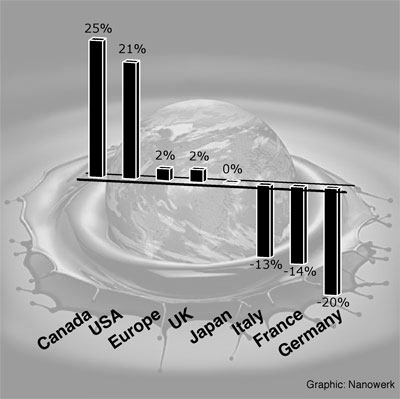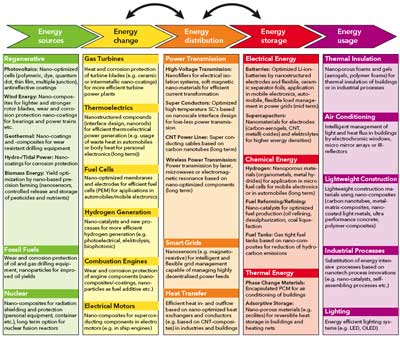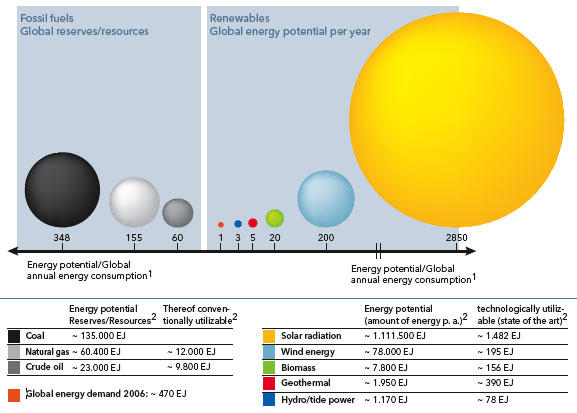| Posted: Sep 25, 2008 | |
Nanotechnology applications could provide the required energy breakthroughs |
|
| (Nanowerk Spotlight) Nanotechnology applications could provide decisive technological breakthroughs in the energy sector and have a considerable impact on creating the sustainable energy supply that is required to make the transition from fossil fuels. Possibilities range from gradual short- and medium-term improvements for a more efficient use of conventional and renewable energy sources all the way to completely new long-term approaches for energy recovery and utilization. With enough political will – and funding – nanotechnology could make essential contributions to sustainable energy supply and global climate protection policies. The technological foundation is there, all it takes is political leadership to create the right research and investment conditions to make it happen. | |
| In our recent Nanotechnology Spotlight "Why don't we have a nanotechnology Apollo Program for clean energy?" we showed this intriguing chart that depicted the vastly diverging energy consumption patterns between North American economies and the major European countries.: | |
| Change in Petroleum Consumption for G7 Countries 1980-2007 | |

|
|
| Change in petroleum consumption for G7 countries on the basis of million barrels per day (G8 couldn't be compiled because data for Russia is only available from 1992, after breakup of the Soviet Union); All of Europe also shown in comparison. Data source: U.S. Department of Energy, Energy Information Administration. Compilation and chart: Nanowerk) | |
| While the current financial markets meltdown in the U.S. provides yet another example of the foolishness of a reckless "hands off the markets" political philosophy, the lack of a comprehensive and decisive energy policy towards clean and renewable energies could result in incommensurably bigger long-term costs – and it will affect the entire planet. | |
| In stark contrast to the U.S., European countries in general, and Germany in particular, provide an example of what deliberate, informed and forward-looking government policies not impacted by oil lobbyists can do to facilitate their societies' move towards renewable energies (although critics in these countries say it still is not enough). Germany for instance – not exactly a sun-drenched region – has established itself as a world-leading center for photovoltaics (PV) technology, thanks to legislation designed to encourage its development. | |
| The strength of PV technology in Germany is reflected in its figures. Analysts place the country as by far the largest PV market, with a turnover of 3.7 billion euros (approx. $5.5 billion) in 2006 and expected double-digit growth rates for the upcoming years, according to Invest in Germany. Indeed PV has become such big business, especially in eastern Germany, that people have even begun to predict that it could overtake Germany's automotive industry in size (read: German legislation generates photovoltaic leadership). | |
| An example of the active role of German government not only on the federal but also the state level can be found in the new 88-page Application of Nanotechnologies in the Energy Sector brochure (pdf download, 4 MB) issued by the State of Hesse. It describes which nanotechnology solutions can already be applied today and for which issues new solutions will be available only in the medium to long run. The goal is to further trigger scientific and corporate innovation processes that industry and political leaders feel are urgently required. | |
| According to the authors, nanotechnologies provide the potential to enhance energy efficiency across all branches of industry and to economically leverage renewable energy production through new technological solutions and optimized production technologies. Nanotechnology innovations could impact each part of the value-added chain in the energy sector: | |
 |
|
| Examples for potential applications of nanotechnology along the value-added chain in the energy sector (Source: VDI TZ GmbH). (click image to enlarge) | |
| Let's look at these five areas of the energy value chain in detail (the following summaries are taken directly from the brochure). | |
| Sources | |
| Nanotechnologies provide essential improvement potentials for the development of both conventional energy sources (fossil and nuclear fuels) and renewable energy sources like geothermal energy, sun, wind, water, tides or biomass. Nano-coated, wear resistant drill probes, for example, allow the optimization of lifespan and efficiency of systems for the development of oil and natural gas deposits or geothermal energy and thus the saving of costs. | |
| Further examples are high-duty nanomaterials for lighter and more rugged rotor blades of wind and tidepower plants as well as wear and corrosion protection layers for mechanically stressed components (bearings, gear boxes, etc.). Nanotechnologies will play a decisive role in particular in the intensified use of solar energy through photovoltaic systems. In case of conventional crystalline silicon solar cells, for instance, increases in efficiency are achievable by antireflection layers for higher light yield. | |

|
|
| 1 EJ = 1 exajoule or 1018 joules or ∼163 million barrels of oil. Global potential of available renewables and fossil fuels 1: Data referring to global energy consumption of 390 EJ in 1997, data from M. Fischedick, O. Langniß, J. Nitsch: "Nach dem Ausstieg – Zukunftskurs Erneuerbare Energien", S. Hirzel Verlag, 2000 2: Data source: German Federal Institute for Geosciences and Natural Resources. | |
| First and foremost, however, it will be the further development of alternative cell types, such as thin-layer solar cells (among others of silicon or other material systems like copper/indium/selenium), dye solar cells or polymer solar cells, which will predominantly profit from nanotechnologies. Polymer solar cells are said to have high potential especially regarding the supply of portable electronic devices, due to the reasonably-priced materials and production methods as well as the flexible design. | |
| Medium-term development targets are an efficiency of approx. 10% and a lifespan of several years. Here, for example, nanotechnologies could contribute to the optimization of the layer design and the morphology of organic semiconductor mixtures in component structures. In the long run, the utilization of nanostructures, like quantum dots and wires, could allow for solar cell efficiencies of over 60%. | |
| Conversion | |
| The conversion of primary energy sources into electricity, heat and kinetic energy requires utmost efficiency. Efficiency increases, especially in fossil-fired gas and steam power plants, could help avoid considerable amounts of carbon dioxide emissions. | |
| Higher power plant efficiencies, however, require higher operating temperatures and thus heat-resistant turbine materials. Improvements are possible, for example, through nano-scale heat and corrosion protection layers for turbine blades in power plants or aircraft engines to enhance the efficiency through increased operating temperatures or the application of lightweight construction materials (e.g. titanium aluminides). | |
| Nano-optimized membranes can extend the scope of possibilities for separation and climate-neutral storage of carbon dioxide for power generation in coal-fired power plants, in order to render this important method of power generation environmentally friendlier in the long run. The energy yield from the conversion of chemical energy through fuel cells can be stepped up by nano-structured electrodes, catalysts and membranes, which results in economic application possibilities in automobiles, buildings and the operation of mobile electronics. | |
| Thermoelectric energy conversion seems to be comparably promising. Nano-structured semiconductors with optimized boundary layer design contribute to increases in efficiency that could pave the way for a broad application in the utilization of waste heat, for example in automobiles, or even of human body heat for portable electronics in textiles. | |
| Distribution | |
| Regarding the reduction of energy losses in current transmission, hope exists that the extraordinary electric conductivity of nanomaterials like carbon nanotubes can be utilized for application in electric cables and power lines. Furthermore, there are nanotechnological approaches for the optimization of superconductive materials for lossless current conduction. | |
| In the long run, options are given for wireless energy transport, e.g. through laser,microwaves or electromagnetic resonance. | |
| Future power distribution will require power systems providing dynamic load and failure management, demand-driven energy supply with flexible price mechanisms as well as the possibility of feeding through a number of decentralized renewable energy sources. | |
| Nanotechnologies could contribute decisively to the realization of this vision, inter alia, through nano-sensory devices and power-electronical components able to cope with the extremely complex control and monitoring of such grids. | |
| Storage | |
| The utilization of nanotechnologies for the enhancement of electrical energy stores like batteries and super-capacitors turns out to be downright promising. Due to the high cell voltage and the outstanding energy and power density, the lithium-ion technology is regarded as the most promising variant of electrical energy storage. | |
| Nanotechnologies can improve capacity and safety of lithium-ion batteries decisively, as for example through new ceramic, heat-resistant and still flexible separators and high-performance electrode materials. The company Evonik pushes the commercialization of such systems for the application in hybrid and electric vehicles as well as for stationary energy storage. | |
| In the long run, even hydrogen seems to be a promising energy store for environmentally-friendly energy supply. Apart from necessary infrastructural adjustments, the efficient storage of hydrogen is regarded as one of the critical factors of success on the way to a possible hydrogen management. | |
| Current materials for chemical hydrogen storage do not meet the demands of the automotive industry which requires a H2-storage capacity of up to ten weight percent. | |
| Various nanomaterials, inter alia based on nanoporous metal-organic compounds, provide development potentials which seem to be economically realizable at least with regard to the operation of fuel cells in portable electronic devices. | |
| Another important field is thermal energy storage. The energy demand in buildings, for example, may be significantly reduced by using phase change materials such as latent heat stores. Interesting, from an economic point of view, are also adsorption stores based on nanoporous materials like zeolites, which could be applied as heat stores in district heating grids or in industry. The adsorption of water in zeolite allows the reversible storage and release of heat. | |
| Usage | |
| To achieve sustainable energy supply, and parallel to the optimized development of available energy sources, it is necessary to improve the efficiency of energy use and to avoid unnecessary energy consumption. This applies to all branches of industry and private households. Nanotechnologies provide a multitude of approaches to energy saving. | |
| Examples are the reduction of fuel consumption in automobiles through lightweight construction materials on the basis of nanocomposites, the optimization in fuel combustion through wear-resistant, lighter engine components and nanoparticular fuel additives or even nanoparticles for optimized tires with low rolling resistance. | |
| Considerable energy savings are realizable through tribological layers for mechanical components in plants and machines. Building technology also provides great potentials for energy savings, which could be tapped, for example, by nanoporous thermal insulation material suitably applicable in the energetic rehabilitation of old buildings. | |
| In general, the control of light and heat flux by nanotechnological components, as for example switchable glasses, is a promising approach to reducing energy consumption in buildings. | |
| Real-world examples | |
| To demonstrate that the report's authors don't live in cloud-cuckoo-land the brochure lists 10 examples of organizations in the State of Hesse alone that apply nanotechnology to practical energy applications: | |
|
|
|
| The brochure also includes a whole raft of research programs, financing and funding opportunities available in Europe and Germany. | |
| Go ahead and download and read this this very useful and informative brochure. It contains loads of data, charts and technical examples, all put in a practical context. It also demonstrates what it looks like when politicians engage in a responsible energy policy. | |
 By
Michael
Berger
– Michael is author of three books by the Royal Society of Chemistry:
Nano-Society: Pushing the Boundaries of Technology,
Nanotechnology: The Future is Tiny, and
Nanoengineering: The Skills and Tools Making Technology Invisible
Copyright ©
Nanowerk LLC
By
Michael
Berger
– Michael is author of three books by the Royal Society of Chemistry:
Nano-Society: Pushing the Boundaries of Technology,
Nanotechnology: The Future is Tiny, and
Nanoengineering: The Skills and Tools Making Technology Invisible
Copyright ©
Nanowerk LLC
|
Become a Spotlight guest author! Join our large and growing group of guest contributors. Have you just published a scientific paper or have other exciting developments to share with the nanotechnology community? Here is how to publish on nanowerk.com.
